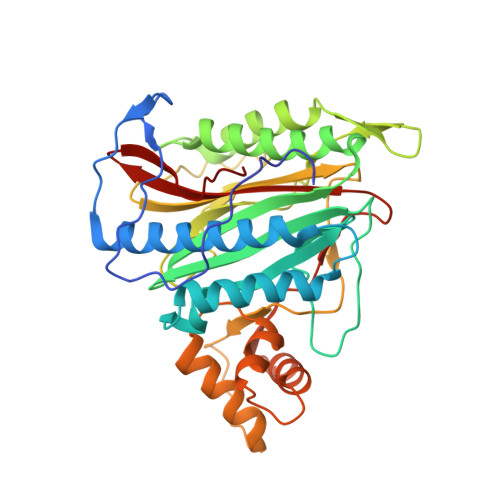Structure of a microsporidian methionine aminopeptidase type 2 complexed with fumagillin and TNP-470.
Alvarado, J.J., Nemkal, A., Sauder, J.M., Russell, M., Akiyoshi, D.E., Shi, W., Almo, S.C., Weiss, L.M.(2009) Mol Biochem Parasitol 168: 158-167
- PubMed: 19660503
- DOI: https://doi.org/10.1016/j.molbiopara.2009.07.008
- Primary Citation of Related Structures:
3FM3, 3FMQ, 3FMR - PubMed Abstract:
Microsporidia are protists that have been reported to cause infections in both vertebrates and invertebrates. They have emerged as human pathogens particularly in patients that are immunosuppressed and cases of gastrointestinal infection, encephalitis, keratitis, sinusitis, myositis and disseminated infection are well described in the literature. While benzimidazoles are active against many species of microsporidia, these drugs do not have significant activity against Enterocytozoon bieneusi. Fumagillin and its analogues have been demonstrated to have activity invitro and in animal models of microsporidiosis and human infections due to E. bieneusi. Fumagillin and its analogues inhibit methionine aminopeptidase type 2. Encephalitozoon cuniculi MetAP2 (EcMetAP2) was cloned and expressed as an active enzyme using a baculovirus system. The crystal structure of EcMetAP2 was determined with and without the bound inhibitors fumagillin and TNP-470. This structure classifies EcMetAP2 as a member of the MetAP2c family. The EcMetAP2 structure was used to generate a homology model of the E. bieneusi MetAP2. Comparison of microsporidian MetAP2 structures with human MetAP2 provides insights into the design of inhibitors that might exhibit specificity for microsporidian MetAP2.
Organizational Affiliation:
Department of Biochemistry, Albert Einstein College of Medicine, Bronx, NY 10461, USA.

















